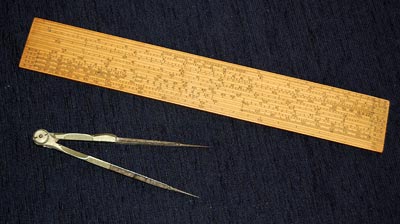 |
|
|
|

|

|
Gunter's rule |
|
|
|
|
|
|
the first table of logarithms in 1614, and armed with it one could replace multiplication and division with addition and subtraction of the equivalent logarithms -- a clear benefit if you have to calculate by hand, as they certainly did in the 17th century. Still, it was one boring and laborious task, which Gunter did away with. |
|
|
|
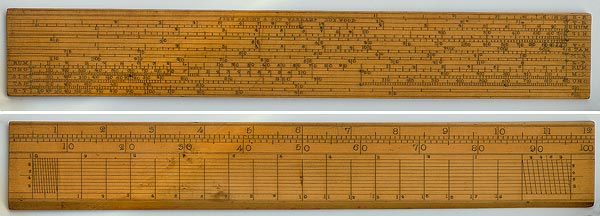 Click photo to enlarge |
|
|
|
Gunter’s rule has many scales, but the revolutionary one is the one marked “NUM”, which has the numbers from 1 through 100 laid out as a two-cycle logarithmic scale. Now, instead of looking up the logarithms in a table, adding them and looking up the result of the multiplication, all you had to do was use a pair of dividers to add the lengths representing the two multiplicands on the NUM scale; the result could be read right off the same scale. The true slide rule, invented by William Oughtred shortly afterward, is simply a pair of Gunter scales juxtaposed to allow adding the lengths without the dividers. |
|
|
|
As an example, consider the simple problem 2 x 3. As the photo shows, you start (top image) by opening the dividers to measure the length from 1 (the left end of the scale) to 2. Then -- without changing the span -- you move the dividers to add this length beyond the mark of 3, ending up at the correct result of 6 (bottom image). Division can likewise be achieved by subtracting lengths on the same scale. |
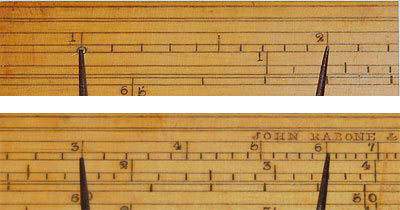 2 x 3 = 6
2 x 3 = 6
|
|
|
|
Given the speed with which this allows you to calculate, it is small wonder that
Gunter’s rule was used well into the 19th century; in fact it was part of the standard equipment kit for
ship navigation in the British fleet. This use is attested to by the many additional scales it carries.
There are scales for doing trigonometry, such as those marked SIN , TAN and SEC, and then there are more
specialized scales for navigation at sea. For example, we see a scale marked M*L, which stands for
“Miles of Longitude”, giving the length of one degree of longitude at a given latitude; or S*R, the Sine
of Rhumbs, which is the log of the sine of an angle given in rhumbs -- which are the standard compass
points (N, NE, E, etc). The more common Gunter was 2 feet long; the one in my collection, pictured here, is a shorter version at one foot. It was made in the 19th century by John Rabone & Son in Birmingham, and it is in exceptionally nice condition, clean and pleasant in its honey colored boxwood. As was usual it has brass plugs at commonly used points to prevent damage to the wood from the points of the dividers, and an interpolation scale on the back to allow measuring lengths with greater precision. |
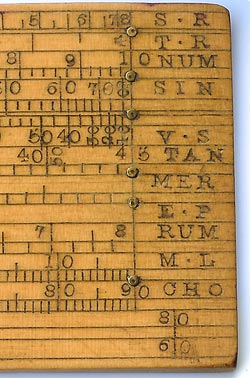 Note the brass plugs! |
|
|
|
It also has, alas, a shameful shortcoming, evident in the photo at right: the dividers here have the same span as in the previous example, and they clearly show that 4X2 = 8.2. The 8 mark (on both cycles of the NUM scale) has been displaced to the left. This is not a limitation due to the accuracy attainable at the time; my Gravet Lenoir slide rule was made in the same period and is |
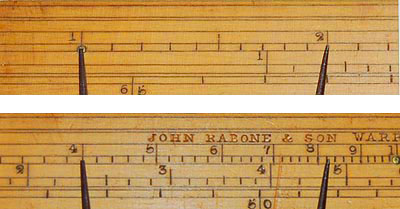 2 x 4 = 8 (NOT)
2 x 4 = 8 (NOT)
|
|
|
|
exquisitely precise. In fact, I also have a Coggeshall pattern carpenter’s slide rule by John Rabone & Sons (sic) that has an accurate pair of logarithmic scales. Note that my Gunter mentions one son, not many; it was thus made between 1845, when John Junior joined his father’s business, and 1877, when Junior’s sons came on board; the carpenter’s rule is from later in the century. Somebody at Rabone’s workshop was careless in those early years, and we can only hope that no ships ran aground as a result! |
|
|
|
Exhibit provenance: eBay, from a seller in Gunter’s homeland. The dividers shown are also from the 19th century, and came from Czechoslovakia. More info: |
|
|
|
|
|
|
|
Home | HOC | Fractals | Miscellany | About | Contact Copyright © 2010 N. Zeldes. All rights reserved. |
|
